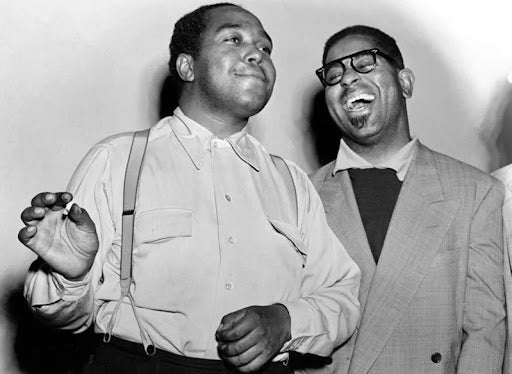The origin story of the bop!
According to The Jazz History Tree, Bebop originated in the 1940s and is largely considered the beginning of today’s modern jazz. Up until that point, jazz had a “dance-oriented swing style,” but new cabaret laws were created during that time to discourage interracial dancing. As a result, younger jazz musicians started playing around more with their technique, developing harmonious music that was a far cry from the sing-songy melodies jazz was used to.
Birthed in Harlem, the leaders of this movement included saxophonist Charlie “Bird” Parker, considered the father of the movement, trumpet player John Birks “Dizzy” Gillespie, and pianist Thelonious Monk. Both Parker and Gillespie formed a group, and they would often stop at Minton’s Uptown Playhouse in Harlem where Monk served as a house pianist. There they perfected the bebop sound and gave jazz its truest form of expression.
The sound focused on craft instead of dance tunes, allowing for more improvisation for the musicians and sparking widespread innovation. Inspired by the rhythmic players from the swing era like Coleman Hawkins, Art Tatum, and Roy Eldridge, bebop expanded what was capable for the musicians and allowed them to play around with faster tempo music, increasing the rhythm section of the band.
The music wasn’t instantly a hit among audiences or musicians, with Louis Armstrong calling the music “noisy.” Many listeners wanted to just dance, and bebop was not for dancing, it was for consuming. Notable musicians of the time included Parker, Gillespie, Monk, Miles Davis, Mary Lou Williams, Sonny Stitt, Dexter Gordon, Lucky Thompson, “Fats” Navarro, Sarah Vaughn, Ella Fitzgerald, Kenny Dorham, Roy Haynes, Milt Jackson, Oscar Pettiford, Charles Mingus, and Max Roach. Nearly a century later, bebop remains one of the biggest influencers on popular music today.
Here’s everything you need to know about the Bebop Movement, courtesy of Master Class.
The sound shifted music away from big bands.
“Bebop traces back to World War II when the draft sent many jazz musicians overseas to fight in the war. The shortage of available talent in the U.S. sparked a shift from the big bands of the swing era to smaller quartets and quintets. With a smaller band size, the jazz style naturally began to rely less on complicated group arrangements and more on individual virtuosity and improvisation.”
There was a group of Bebop pioneers who wanted to create more challenging music.
“In the early 1940s, an innovative group of jazz musicians set out to create a new, more challenging style of jazz. The essence of bebop was born during late-night jam sessions with the Earl Hines Orchestra at Milton’s Playhouse in Harlem, New York. These pioneers included alto saxophonist Charlie Parker, trumpeter Dizzy Gillespie, pianists Thelonious Monk and Bud Powell, drummers Kenny Clarke and Max Roach, and guitarist Charlie Christian.”
Bebop gave birth to different branches of jazz.
“In the late 1940s and early 50s, bebop evolved into a new style called cool jazz, which had a more laid-back, smooth sound that focused on formal arrangements rather than individual improvisation. Trumpet player Miles Davis was the most influential cool jazz musician, and he inspired many Los Angeles-based musicians to adopt the cool jazz genre, resulting in the West Coast jazz style.”
Bebop was ever-evolving.
“In the mid-1950s and 60s, jazz musicians in New York, Philadelphia, and Detroit ushered in a new, heavier style of bebop called hard bop. Hard bop had a more rhythmic drive and incorporated elements from blues and gospel music.”
There are 6 main characteristics of Bebop music.
The 6 main characteristics include faster tempos catered towards listening instead of dancing, small bands with exceptional soloists, now known as the traditional jazz band setup, an expanded rhythm section that doesn’t just keep time but also offers support, riffs, and embellishments, experimentation with complex harmonies and erratic rhythms, improvisation featuring themed melodies instead of arranged songs, and contrafacts, “a music piece consisting of a new melody over a preexisting harmonic structure,” also known as chord progressions.
Check out a rare, televised performance of Dizzy Gillespie and Charlie “Bird” Parker on the Earl Wilson Show in 1952 below.
Here’s everything you need to know about the Bebop movement. (l to r) Charlie Parker & Dizzy Gillespie, New York, 1949. Photo Courtesy of Herman Leonard.

